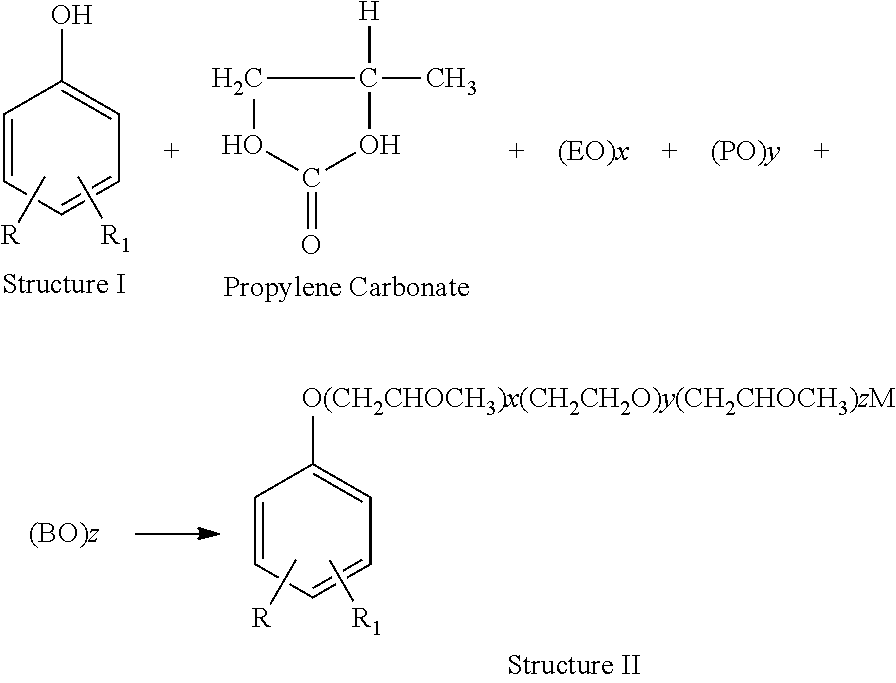Non-estrogenic alkylphenol derivatives
a technology of alkylphenol and derivatives, which is applied in the field of non-estrogenous alkylphenol derivatives, can solve the problems of affecting the extent of estrogenicity, affecting the properties of final surfactants, and affecting the use of phenol ethoxylates and alkylphenol ethoxylates (apes) and their anionic derivatives
- Summary
- Abstract
- Description
- Claims
- Application Information
AI Technical Summary
Benefits of technology
Problems solved by technology
Method used
Image
Examples
example 1
Comparison of Estrogenicities for Various Alkylphenol Alkoxylates
[0033]Table 1 and FIG. 1 show the relative estrogenicity of various alkoxylated alkylphenols compared to estradiol that is assigned an estrogenicity value of unity. From the table it can be seen that 4-t-octylphenol, 4-t-butyl phenol and nonylphenol have relatively high estrogenicity compared to the other products that are nonylphenol (NP) derivatives containing various amounts of ethylene and / or propylene oxide. Nonylphenol that has been ethoxylated, even with up to nine moles of ethylene oxide (EO) per mole of nonylphenol still shows some residual unalkoxylated nonylphenol. All products containing 2 or more moles of PO per molecule of nonylphenol do not show any detectable estrogenicity using results from a standard test procedure recognized in the field, as well as testing for stimulation of vitellogenin gene expression in trout hepatocytes (reference: Jobling et al., “Detergent Components in Sewage Effluent . . . ”...
example 2
Synthesize of p-nonylphenol+1PO+2EO using propylene carbonate
[0037]122.5 g of propylene carbonate (1.18M) was reacted with 234.5 g of nonylphenol using potassium carbonate catalyst. This was analyzed by NMR and Gas Chromatography (GC) and found to contain less than 0.02 wt % free nonylphenol and greater than 99.8% secondary hydroxyls indicating that essentially all the terminal hydroxyls from the nonylphenol had been reacted. This was followed by ethoxylation with 94.2 g (21.4 Moles) of ethylene oxide. This product, a nonyl phenol alkoxylate having 1 mole of PO followed by 2 moles EO, was tested for estrogenicity employing the aforementioned test procedure, and was found not to be estrogenic. It was also shown, via degradation studies that upon degradation this material did not degrade into an estrogenically active material.
[0038]Derivatives of Structure II have found application in many industrial processes including enhanced oil recovery. These products can be formulated to give s...
example 3
[0039]Table II below shows the distribution of nonylphenol homologues obtained by adding various amounts of PO as compare to adding 1 mole of the propylene carbonate to the nonylphenol. Note that the there is a wide distribution of PO homologues for all the products made using propoxylation with PO. The product made using propylene carbonate (NP+1PC) only has 0.017 wt % of un-propoxylated nonyiphenol and 99.98% of the 1 Mole of the PO adduct.
[0040]
TABLE IIHomologue DistributionPONP + 1PCNP + 1.5PONP + 2.5PONP + 3.5PO00.017% 2% 1% 0.5%199.98%52.5%10.3% 0.3%2 7.8%25.6%22.4%312.2%33.9%4 4.3%25.7%5 8.2%10.5%6 5.7%
PUM
| Property | Measurement | Unit |
|---|---|---|
| temperatures | aaaaa | aaaaa |
| adsorption | aaaaa | aaaaa |
| amphoteric | aaaaa | aaaaa |
Abstract
Description
Claims
Application Information
 Login to View More
Login to View More - R&D
- Intellectual Property
- Life Sciences
- Materials
- Tech Scout
- Unparalleled Data Quality
- Higher Quality Content
- 60% Fewer Hallucinations
Browse by: Latest US Patents, China's latest patents, Technical Efficacy Thesaurus, Application Domain, Technology Topic, Popular Technical Reports.
© 2025 PatSnap. All rights reserved.Legal|Privacy policy|Modern Slavery Act Transparency Statement|Sitemap|About US| Contact US: help@patsnap.com



